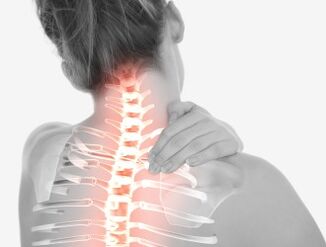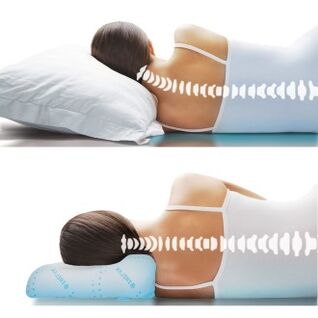
Diseases in the spine are unpleasant in themselves, but they represent the greatest danger if they affect the cervical region.
Even a pathology as harmless asOsteochondrosis of the cervical region, can cause the appearance of headaches, blood circulation difficulties, altered work of internal organs.
In the absence of treatment, osteochondrosis can lead to the development of other more serious diseases.
To avoid this result, you should carefully monitor your health and consult a doctor when the first symptoms of osteochondosis appear.
Fortunately, modern medicine has methods that allow this disease to quickly and effectively treat this disease.
What is this
Cervical osteochondosis is a pathology in whichThe soft intervertebral pulp turns into daring tissue.In addition, blood vessels and nerves roots are involved in pathogenesis.Osteochondrosis in the cervical region has the ability to disguise itself for various disorders.
Clinical image
A distinctive characteristic of cervical osteochondosis is pain in the neck, head, upper back.Patients can complain about dizzy, lack of air, jumps of blood pressure, nausea, numbness of the language, loss of consciousness.Often they suspect angina chest and other diseases of the cardiovascular system.
Classification
The classification of cervical osteochondrosis can be relating to the degree of development of the disease::
- 1 degree - degenerative -system of changes in intervertebral discs occur;
- 2 degree - The vertebrae themselves are subject to changes;
- 3 degrees - Intervertebral hernias appear.
Prevalence and meaning
Osteochondrosis of the cervical column "becomes younger" literally before our eyes.An examination of patients of different ages who tend to osteochondosis have shown that in current young people, problems with the spine occur much earlier (sometimes the first symptoms of the disease appear in adolescence) than representatives of the older generation of the family.
People born 60 to 70 years ago, contact clinics on maturity and old age osteochondrosis, although people born 20 to 40 years ago have enough of osteochondrosis even at a young age.This trend is proof of a significant deterioration in the health of the young generation caused by a decrease in the quality of nutrition and a sedentary lifestyle.
Clinical manifestations of osteochondrosis are in around 60% of adults living in European countries.It should be noted that women obtain cervical osteochondosis in 50 to 55 and men at 45 to 50 years old.
Risk factors
The chances of increasing osteochondrosis if they are available::
- Anomalies in the development of the spine;
- excess weight;
- long physical effort;
- Bad habits (smoking);
- sedentary lifestyle;
- The works, which implies the regular impact of vibrations on the spine (for example, with vehicle drivers);
- Long stress, excessive nervous tension;
- local hypothermia;
- previous injuries in the neck and nape;
- Autoimmune pathologies resulting in degeneration of cartilage.
Reasons
The main reasons for the development of osteochondrosis include::
- genetic predisposition;
- the disturbed metabolic process;
- low physical development.
It is difficult to establish the exact cause of the appearance and development of cervical osteochondosis, because this disease occurs in young people and the elderly involved in sport and leading a sedentary lifestyle.
Psychosomatic
The development of cervical osteochondosis indicates the inability to resist in a competent manner for problems.Sometimes people become so strong and confident in their abilities that their stability before adversity turns into rigidity and lack of flexibility.In this case, attempts to turn your head are accompanied by stiffness, convulsions and other unpleasant sensations.
In addition, osteochondrosis can develop in people who are afraid of problems and do not know how to face it.In this case, the protective reflex of the mammal is triggered and the head is literally attracted in the shoulders.This provision is considered to be unnatural, therefore, after a certain time, the muscles of the cervical region begin to hurt and deform.
Consequences
Decrease in muscle elasticity and flexibility in joints- Signs of natural aging of the body.However, in patients with osteochondrosis, they seem much earlier than in healthy people.Osteochondrosis can cause the development of migraines, hypertension, diseases of the respiratory system, ischemia of spinal cord and brain, brain vascular accidents, etc.
Inappropriate treatment of osteochondrosis is no less dangerousas a lack of treatment.The inept actions of a doctor can cause persistent deterioration in well-being or sudden disability.
Symptoms and diagnostic methods
The main signs of osteochondrosis in the cervical region include::
- pain on the back of the head, neck, arms and shoulder, which intensifies during sneezing, cough and a minimum load on the arm;
- Burn between the shoulder blades, tingling legs or arms, numbness;
- Pain and crunch in the neck that occurs during the inclination and the turns of the head;
- fatigue, weakness;
- faintings and dizziness resulting from clear turns of the head;
- The headaches, which generally start at the back of the head, spread to the temples and the crown.
The other signs of cervical osteochondosis include noise in the ears, hearing disorders and a decrease in visual acuity.Sometimes the disease is felt by pulling pain in the heart zone.
During the first signs of cervical osteochondosis, you should consult a doctor who will carry out a complete examination, will diagnose.In this case, diagnostic methods such as MRI, laboratory studies, ultrasound, ECG can be used.
Treatment
The treatment of cervical osteochondosis depends on the stage of the disease.If at the first stage, there is sufficiently conservative and wandering treatment, then in the second and third stages, the doctor's task is, first of all, to stop pain syndrome.Improved cases may require surgical treatment intended for decompression and stabilization of the vertebrae.
Drug
People with osteochondrosis in the cervical region can be prescribed::
| Band | Description |
| NSAIDs (non-steroidal anti-inflammatory drugs) | Help eliminate swelling and pain. |
| Vasodilators | Contribute to improving blood circulation. |
| Sedatives, muscle relaxing | They are also prescribed to facilitate the general condition of the patient and reduce the doses of NSAIDs.Reliered at the same time the nerve nerve cramps and muscle cramps, help get a better therapeutic effect. |
At the end of the therapy, NSAIDs should be purchased for a home kit first, because pain in the neck can be returned periodically (with stress, on -cas, meteorological change).Before taking medication, see your doctor.
Surgical treatment
If a positive effect is not observed after a conservative treatment of a conservative treatment, the doctor may recommend the patient in fussy.This procedure allows you to immobilize the assigned vertebral segment.Its essence is to eliminate the intervertebral disc, the decompression of the nerve root, the installation of the implant or the creation of the physiological height of the disk space.
The operation has many side effects and contraindications.Thus, this can cause a vertebrogenic handicap.This is why surgery is carried out in extreme cases.
Exercises, exercise therapy, massage
Massage with cervical osteochondosis allows you to obtain notable improvements.It is important that the procedure is carried out by a professional: incompetent movements in the field of the cervical column can worsen the situation.The movements must affect the collar area, the cervical region and part of the back.

Massage for osteochondrosis implies the alternation of the following actions.
- Caressing.The masseur affects the surface layers of the skin, moving from the head to the upper third of the middle of the back.At the same time, the palms or the fingers work.
- Pressing.Deep layers of the skin located in the upper third of the back are exposed.In this case, the index and thumb of the hands through the neck are made to take the skin.The tissues adjacent to the vertebrae are not involved in this process.
- Trituration.It is made to warm the skin, increase blood flow in the neck area.The procedure must be carried out extremely carefully.It is forbidden to influence the thorny processes of the vertebrae.Sometimes the friction is replaced by circular lines or movements resembling sawing.
- Kneading.It affects deeply lies tissues, so it has a limited value.It can worsen pathology.
During the massage, the patient must lie on the belly, in extreme cases, sit down.
It can also be useful for cervical osteochondrosis.Regular classes contribute to the strengthening of the muscle corset, reducing the load on the cervical column.You can practice exercise therapy at any stage of pathology, as well as for prevention.During exacerbations, the complex is carried out with particular caution.
Standard exercises for the treatment of cervical osteochondrosis are::
- turns from the head from one side to the other;
- Tilt back and forward;
- Raise the shoulders with fixed or relaxed hands with their grip in this position of 15 to 20 seconds;
- Depending on the extensors and flexors of the neck, when the head is in a fixed position.
Each exercise is repeated five to seven times.The lesson continues for 15 to 20 minutes.All the exercises must be selected by the LFK specialist, taking into account the stage of the disease and the patient's state.
Home treatment
The treatment of osteochondrosis at home is rarely practiced, for example, in the first stage of the disease.
In this case, the patient is recommended::
- Adjust the posture;
- Equip a workplace correctly;
- Do simple physical exercises, including the workplace.
A positive impact on the musculoskeletal system will have the use of vitamins and minerals, an increase in motor activity, as well as swimming.
Prevention

For the prevention of the disease, it is recommended::
- Sleep on a pillow and an orthopedic mattress;
- Take a hot shower every day for 10 minutes;
- Visit a bath or sauna (relieves cramps from the neck muscles);
- Avoid inclinations and acute turns of the head;
- Walking more on foot, making yoga and swimming;
- With the work "seated", take five -minute breaks every hour (you must walk during the breaks, inclination with a body and your head in different directions);
- Avoid increased load on the spine: classes with weights, jumps, race;
- Choose chairs and chairs supporting the spine;
- abandon dependencies, such as smoking, alcohol abuse;
- Drink at least one and a half liters of water per day.
Eating with cervical osteochondosis is often recommended (at least five times a day) and small portions.The preference must be given to cooked or cooked dishes.Salads must be seasoned with olive oil.
Recovery of the recovery
Forecasts for qualified and appropriate treatment are a favorableHowever, many depends on the age of the patient, the severity of the manifestations and the stage of the disease.It is also important in which the person makes medical recommendations concerning nutrition, lifestyle and eliminating bad habits.
Conclusion
So, in most casesOsteochondrosis of the cervical regionIt is possible to heal.However, it should be remembered that the disease can come back at any time.To avoid this, it is necessary to observe preventive measures and a healthy lifestyle.
In addition, it is worth remembering::
- The cause of osteochondrosis is difficult to establish.
- The symptom of the disease is pain on the back of the head and neck.
- Cervical osteochondosis is treated in depth: drugs (mainly NSAIDs), massages, exercise therapy.























